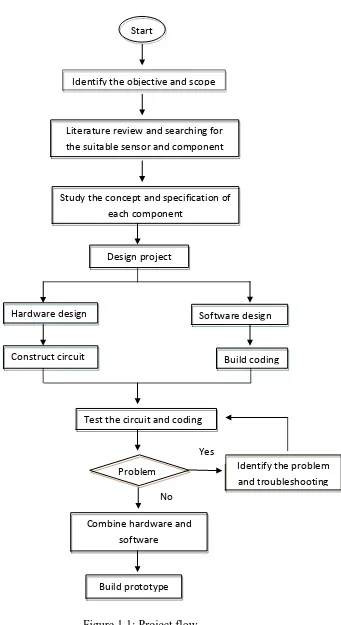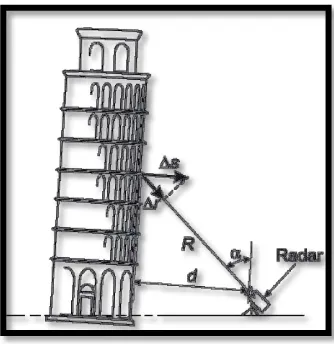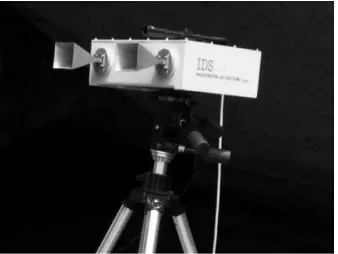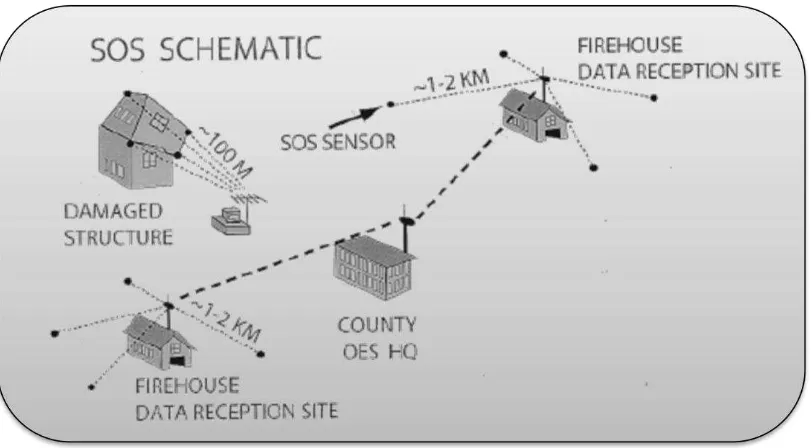HIGH RISE BUILDING ALERT SYSTEM
CHIN XIN YAN
This report is submitted in partial fulfillment of the requirement for the Bachelor Degree of Electronic Engineering (Industrial Electronics) with
Honours
ACKNOWLEDGEMENT
A paper is not enough for me to express my appreciation, however I would
like to take this opportunity to express my special thank to my supervisor, Prof
Madya Tan Kim See for giving his encouragement, support and guidance throughout
this whole project. Under his supervision, I acquired a lot of valuable knowledge and
advices as well as confidence to complete the project. Therefore, here am I to show
my appreciation to him for teaching me patiently and grateful to have s supervisor.
A special thanks to my friend who are always ready to help me when I was in
difficulty. Besides that, appreciation toward my friend for sharing a lot of good ideas
to improve my project.
Last but not least, I would like to show my gratitude to my parents, Chin See
Khoon and Haw Wai Min for supporting me physically and mentally from time to
ABSTRACT
Every now and then, the world is shocked with news that another building
has collapsed causing many innocent people who are occupying the building to lose
their lives and bringing untold miseries and sufferings to those who are lucky to
survive the tragedy. And, on many occasions, unless being attacked deliberately, a
building does not collapse out of the blue. Most of the incidents of buildings
tumbling down show evidence the structure or foundation of the buildings have been
shifted or disturbed due to earth movement beneath the buildings over a period of
time. For a high-rise square or rectangular shaped structure, the possibility of the
building leaning to its side due to earth movement is most likely. It will either lean to
the east, west, south or north, or that matter, north-east, south-east, south-west or
north-west, very much in the cross formation. An automatic detecting system that
constantly monitors the stability of the building, if installed in a high-rise building
will be most beneficial. Any leaning of the building by any degree to either any of
the directions, the system is able to detect immediately. Any such detection, the
management of the building will be the first to be informed so that immediate action
can be taken to investigate the seriousness of the inclination where remedial work
can be undertaken. However, if the management somehow fails to response, the
system will send a message via SMS to the occupants when the inclination has
reached the danger level so that the occupants have enough time evacuate the
ABSTRAK
Setiap sekarang dan kemudian, dunia dikejutkan dengan berita bahawa
sebuah lagi bangunan telah runtuh menyebabkan ramai orang yang tidak bersalah
yang menduduki bangunan yang kehilangan nyawa mereka dan membawa
kesengsaraan dan penderitaan orang-orang yang bernasib baik untuk terus hidup
tragedi itu. Dan, banyak kali, melainkan jika diserang sengaja, bangunan yang tidak
runtuh daripada biru. Kebanyakan kejadian bangunan runtuh menunjukkan bukti
struktur atau asas kepada bangunan telah dipindahkan atau terganggu disebabkan
oleh pergerakan bumi di bawah bangunan dalam tempoh masa. Bagi struktur
berbentuk bertingkat tinggi persegi atau segi empat tepat, kemungkinan bangunan itu
bersandar kepada sampingan disebabkan oleh pergerakan bumi adalah yang paling
mungkin. Ia sama ada akan bersandar ke timur, barat, selatan atau utara, atau perkara
itu, utara-timur, selatan-timur, barat atau utara-barat, sangat banyak dalam
pembentukan silang. Satu sistem pengesanan automatik yang sentiasa memantau
kestabilan bangunan itu, jika dipasang di bangunan tinggi akan paling bermanfaat.
Mana-mana bersandar bangunan itu dengan apa-apa ijazah untuk sama ada apa-apa
arahan, sistem ini dapat mengesan dengan segera. Mana-mana pengesanan itu,
pengurusan bangunan itu akan menjadi yang pertama untuk dimaklumkan supaya
tindakan segera boleh diambil untuk menyiasat seriusnya kecenderungan di mana
kerja pemulihan boleh dilaksanakan. Walau bagaimanapun, jika pengurusan entah
bagaimana gagal untuk tindak balas, sistem akan menghantar mesej melalui SMS
kepada penghuni apabila kecenderungan itu telah mencapai tahap bahaya supaya
penghuni mempunyai masa yang cukup mengosongkan bangunan itu sebelum ia
2.4 Wireless Sensor Network ... 11
2.6 Summarize of literature review ... 13
6. METHODOLOGY ... 15
4.2 Analysis and data collection ... 37
4.2.1 Data collection of output voltage ... 37
i.
LIST OF TABLES
TABLE TITLE PAGE
Table 3.1 Operating voltage and sensitivity of accelerometer. 24
LIST OF FIGURES
Figure 3.1 K-Chart of methodology 16 Figure 3.2 Basic concept of the system 17
Figure 3.14 (a): Accelerometer original position. (b) Accelerometer titled to certain angle. 25
Figure 3.15 Basic circuit of PIC 16F877A 28
Figure 3.16 Connection of LM7805 with PIC. 29 Figure 3.17 (a) Top view of TC35 modem board layout. (b) Bottom view of TC35 30
Figure 3.18 Connection of GSM modem with microcontroller. 31
FIGURE TITLE PAGE
Figure 4.5 Building is tilted backward at 9° 44 Figure 4.6 Building is tilted forward at 3°. 44 Figure 4.7 Building is tilted forward at 9° 45 Figure 4.8 Building is tilted to right at 3°. 45 Figure 4.9 Building is tilted to right at 9° 46 Figure 4.10 Building is tilted to left at 3°. 46
Figure 4.11 Building is tilted to left at 9° 47
Figure 4.12 Circuit connection with GSM. 48
Figure 4.13 Content of the message. 49
Figure 4.14 Prototype of the building 49
CHAPTER 1
INTRODUCTION
1.1 Overview of the project
Building is a structure which is designed to provide convenience and shelter
to the people. However, at the same time, the collapse of a building especially with
many occupants in it will also bring catastrophic result of sufferings and miseries to
the victims. A building does not collapse without any reason. It might be due to some
factors like bad design, faulty construction, foundation failure or lack of proper
safety standards and unenforced building codes that lead to the building tumbling
over. Once the foundation of the building is no longer sustainable, it is unavoidable
that the building will collapse without any warning if no proper detection system is
installed.
However, with an efficient alert system installed in the building to monitor
the stability of the building, the system will be send an alarm to notify the occupants
where the occupants could be forewarned of the danger and effort can be taken to do
remedial work or to evacuate the building before the building tumbles over. By doing
so, lives and properties can be saved. This project researches into the various systems
and the final outcome expected is a system that can be installed in all high-rise
buildings to safeguard the lives and properties of the public. If the building remains
in its original position, the system will remain neutral but once it detects any leaning
in the building using its smart sensor, the system will send the necessary warning to
1.2 Project Objectives
The objective of this project is to design a systematic system by using an
accelerometer as the smart sensor, to monitor the stability of the building and being
able to send message via SMS once there is any indication that the building is
slanting to its side. Besides that, the purpose of the project is to provide an early
indicator to the occupants or the management of the building instability for any
necessary precaution and appropriate action to be taken.
1.3 Problem Statement
On many occasions, building collapsing is unpredictable because most of the
time, any slight movement of the building structure is hardly noticeable by the naked
eyes more so with people nowadays so busy with their daily routine that the safety of
the building they are occupying being taken for granted. By the time the inclination
has reached a certain level, the unavoidable will happen, the building will collapse
which by then is too late. A very good example that happened in the local front was
the Highland Tower which collapsed on 11 December 1993 and caused a total
number of 48 people being killed in the tragedy. This tragic incident had brought
untold pain and miseries to those who lost their loved ones and till today it still brings painful reminder of one of the nation’ worst ecological calamities.
As an engineer, it is one’s duty and responsibility to provide solution to
engineering problem such as the Highland Towers Disaster from happening and to
accord the safety and happiness of the people. Therefore, to design a system to
constantly monitor the stability of the building all the time and is able to detect and
send messages to the appropriate parties such as to the control room operator and the
occupants by using GSM modem will benefit many people. This system will be able
to operate throughout the day, and it is more reliable with such a system installed to
1.4 Scope of Work
This project consists of three major parts, which is the detection system,
control system and notification system. For the detection system, it comprises of
an accelerometer acting as a smart sensor to detect the inclination of the building.
The control system consists of a microcontroller with the main role of receiving
the signal from the sensor and control the process on the various danger level
specified. For notification part, a GSM modem will be used to send message to
the control room operator or the occupants of the building. This system is best
applied to all high-rise buildings, especially those with high human occupancy
and residential building.
1.5 Brief Review of Methodology
The project work started off by first, identifying the objectives and scope of
the project in order to achieve the final outcome. This was followed by doing some
literature reviews to survey and finding the most appropriate sensor, microcontroller
and notification system to be applied. The next move was to study about the function
and specification of each component and sensor in order to achieve the objectives of
the project. Besides that, a lot of other work related to this project such as reviewing
existing systems installed like the leaning Tower of Pisa was done to acquire as
much knowledge and ideas to produce a relevant and useful system. After things
were in place with the literature review and research, the project proceeded with the
design of the hardware and software. Proteus software was used to design the
electronic circuitry whereas for the microcontroller C language was used to build the
various coding.
After the design of hardware and software was properly done and completed,
the system was tested to determine the functionality of each section and
troubleshooting and corrective actions were taken part upon any problem being
encountered. After everything was thought to be functioning in a proper order, the
hardware and software were the integrated and finally the prototype was built. The
Start
Identify the objective and scope
Literature review and searching for the suitable sensor and component
Study the concept and specification of each component
Design project
Hardware design Software design
Construct circuit Build coding
Test the circuit and coding
Problem Identify the problem and troubleshooting
Combine hardware and software
Build prototype No
Yes
1.6 Thesis Outline
This thesis consists of five main chapters, viz., introduction, literature review,
methodology, results and conclusion. The first chapter is an introduction in which the
chapter will provide a brief description of the project to be implemented such as the
background, problem statement project objectives, project scope and methodology.
The second chapter is on literature review, searching and looking up as many
journal papers, articles and videos of previous high rise building collapsing, review
on the theoretical concept on the various methods and applications currently being
used to monitor the stability of high-rise buildings.
The third chapter discusses the project methodology which deliberates on the
possible methods and the processes of the project. The various scope of work and the
flow of going about executing the whole project are outlined here. The sourcing for
the sensors and other components, how they work and how they can be applied in the
project are also discussed in the chapter.
The fourth chapter is the chapter that presents all the result, the circuit and
data collection and how the project works.
The fifth chapter covers the conclusion and recommendations. The final
outcome and success of the project are mentioned. This section will include
CHAPTER 2
LITERATURE REVIEW
2.1 Introduction
This part discusses on the various literature reviews of previous projects or
researches done by using sensor to monitor the stability of the structure building.
Each published paper works on different types of sensors and principles to monitor
the stability of a building. After carefully studying and reviewing the papers, the final
decision on the direction of the project was taken, keeping in mind the ideas applied
by past researchers.
2.2 Interferometric Sensor
The Leaning Tower of Pisa is one of the world-famous architectural marvels of Italian heritage. The tower was designed to be ‘vertical’ but it started to incline during its construction. Although, there were much effort had been taken to stop the
inclination, it kept on sliding over the centuries. Currently, this tower is tilting about
5.5° toward the south [9]. The people are really concern about the increase in its
leaning angle. Therefore, this project is to design a suitable system to provide
continuous monitoring system to constantly keep track of the stability of the tower,
Figure 2.1: Position of the radar and the tower.
Recently, some researchers had developed remote-sensing equipment based
on the principle of microwave radar interferometry [1] and had been experimented
on the tower in order to measure the stability of the tower without requiring any
contact with its structure. The radar is place outside of the tower and is shown in
Figure 2.1. Interferometry sensor are basically two types; one is laser interferometry
and other one is high speed radar interferometry. Some similar techniques have been
carried out to take the measurements by using laser interferometry. However this
laser interferometry is impractical because laser is sensitive to dust and
environmental changes. Therefore, it is not suitable for long term monitoring
whereas the high speed radar interferometry are robust instrument that is suitable for
continuous surveying [1].
High speed radar interferometry has been recently developed as a potential
sensing technique for remote dynamic surveying of structure such as bridges,
viaducts and towers [3][4]. This technique is attractive for surveying the stability of
Figure 2.2: Sensor ‘s appearance.
This radar interferometry’s concept is like microwaves, where the radar transmits the light to the structure of the building and then the structure of the
building scatters back the energy light back to the radar. The radar concept is shown
in the Figure 2.3. The tower movement is able to be determined by measuring the
resonant frequencies. The precision of the measurement of the frequencies depends
on the signal to noise ratio (SNR) and the distance of the building and its radar cross
section. The higher the SNR, the higher is the precision of the measurement. This
high speed interferometry is able to detect the object from distances as far as 1 km
[5].
2.3 Structural Orientation Sensor (SOS) system
The Structural Orientation Sensor system is another technique applied on the
building in order to monitor the stability of the building and provide the emergency
response during earthquake or any natural disaster. The goal of this system is to
identify the structure that have been partially or totally collapsed, and notification
will be sent out to the human emergency responders such as fire station, police
station and hospital within a few minutes after the collapse [6]. Besides that, this
SOS system is able to monitor the damaged structure and debris piles as well as able
to detect the potential slope failures and structure built thereon.
A structural component that has a large tilt such as 3-10° is consider that the
structure is certainly badly damaged [6]. For the structural component with smaller
tilt may indicates important but not immediately life-threatening damage just like
stated in the Uniform Building Code (UBC). This SOS system consists of SOS tilt
detection transmitters and SOS receiver.
The size of the SOS tilt detection is small like the size of a smoke detection.
The user was able to purchase the SOS tilt detection as many as they want and place
it on any part of the structure of the building likes;
a) Soft first structures such as 2-4 storey wood frame apartment building over
Any tilt changes on the structure of the building, the SOS tilt detection will detect it
and will reporting the response from the structure of the building to the emergency
SOS receivers consist of telemetry receiver which receive the signal from the
transmitter and broadcast the tilt change status message to the receiver in order to
activate some desired response from the emergency responders. The SOS receiver is
deployed at all rescue team like fire stations, police station and ambulance in urban
area which serves areas about 2 miles radius. When the receiver received the tilt changes status messages, a typical message might be “I’m sensor # 45366 and I have tilt change of 23°. This will let the responder knowledge the location of the sensor in
the structure then the responders will able to get to the scene in the fastest time.
.



